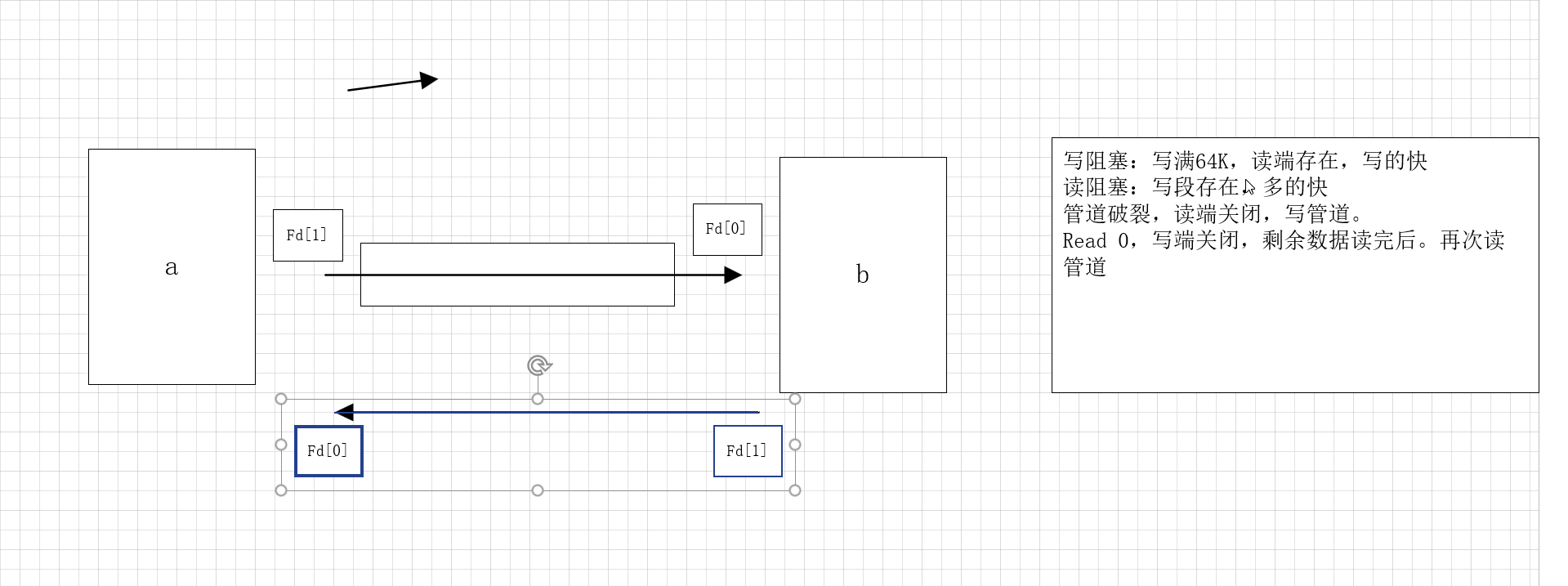嵌入式解谜日志之Linux操作系统—进程间的通信(IPC):无名管道,有名管道,信号通信5
在操作系统中,进程间通信(IPC,Inter-Process Communication) 是指不同进程之间传递数据、共享资源或协调行为的机制。由于进程拥有独立的内存空间(隔离性),不能直接访问彼此的内存,因此需要操作系统提供专门的 IPC 机制。
通信方式分类
古老通信方式
- 无名管道、有名管道、信号通信
- 特点:信号通信是唯一的异步通信机制
IPC对象通信(System V)
- 消息队列(较少使用)
- 共享内存(最高效的通信方式)
- 信号量集
Socket通信
- 用于网络通信
一、IPC 的主要目的
- 数据交换:进程之间传递数据(如文件内容、网络数据)。
- 同步:协调多个进程的执行顺序(如 “先生产后消费”)。
- 共享资源:多个进程共享硬件设备或文件(如打印机、数据库)。
- 通知事件:一个进程向其他进程发送事件信号(如进程退出、数据就绪)。
二、常见的进程间通信方式
1. 无名管道(Pipe)与命名管道(FIFO)
适用场景:父子进程或亲缘进程间的单向字节流通信,适用于少量数据传输。
无名管道(Pipe):
- 特点:半双工(单向传输),仅存在于内存中,生命周期随进程,只能用于有亲缘关系的进程(如父子进程)。
- 核心函数:
pipe(int fd[2]),创建读端(fd[0])和写端(fd[1])。 - 特殊文件:读写使用
read/write,不支持文件定位 - 容量限制:Linux系统中管道容量为64KB(16页,每页4KB)
- 阻塞规则:
- 读端存在时,写满64KB会阻塞
- 写端存在时,空管道读操作会阻塞
- 读端关闭时写操作触发
SIGPIPE信号 - 写端关闭时读操作返回0(表示结束)
无名管道
特性
- 仅限亲缘关系进程使用(父子/兄弟进程) //父进程写,子进程读
- 有固定读写端:
fd[0]为读端,fd[1]为写端 - 必须在
fork()前创建
使用框架
- 创建管道:
pipe() - 读写管道:
read()/write() - 关闭管道:
close()
1.创建管道:
#include <unistd.h>
int pipe(int pipefd[2]);
int fd[2] = {0}; // 管道文件描述符数组int ret = pipe(fd); // 创建无名管道- 功能:创建并打开无名管道
- 参数:
pipefd[0]:管道读端pipefd[1]:管道写端
- 返回值:成功返回0,失败返回-1
管道读阻塞示例 (01pipe_read_block.c)
#include <stdio.h>
#include <stdlib.h>
#include <string.h>
#include <unistd.h>int main(int argc, char *argv[])
{int fd[2] = {0}; // 管道文件描述符数组int ret = pipe(fd); // 创建无名管道if (-1 == ret){perror("pipe");return 1;}pid_t pid = fork(); // 创建子进程if (pid > 0) // 父进程{close(fd[0]); // 关闭读端char buf[] = "hello,child"; // 待写入数据sleep(3); // 延迟3秒write(fd[1], buf, strlen(buf) + 1); // 写入管道}else if (0 == pid) // 子进程{close(fd[1]); // 关闭写端char buf[50] = {0}; // 读缓冲区read(fd[0], buf, sizeof(buf)); // 从管道读取(会阻塞等待)printf("child, buf:%s\n", buf); // 打印读取内容}else {perror("fork");return 1;}return 0;
}
理想运行结果:
子进程阻塞3秒后,打印:
child, buf:hello,child
#include <stdio.h>
#include <stdlib.h>
#include <string.h>
#include <unistd.h>int main(int argc, char *argv[])
{int fd[2] = {0};int ret = pipe(fd);if (-1 == ret){perror("pipe");return 1;}pid_t pid = fork();if (pid > 0) // 父进程{close(fd[0]);char buf[1024] = {0};memset(buf, 'a', sizeof(buf)); // 填充'a'int i = 0;for (i = 0; i < 65; i++) // 超过64KB容量{write(fd[1], buf, sizeof(buf));printf("i is %d\n", i); // 观察写阻塞点}}else if (0 == pid) // 子进程{close(fd[1]);sleep(5); // 延迟读取char buf[50] = {0};read(fd[0], buf, sizeof(buf));printf("child, buf:%s\n", buf);}else {perror("fork");return 1;}return 0;
}
理想运行结果:
父进程打印i is 0到i is 63后阻塞(64次×1024=64KB),第64次写入后继续打印i is 64。子进程5秒后读取并打印64个'a'。

管道破裂示例
#include <stdio.h>
#include <stdlib.h>
#include <string.h>
#include <unistd.h>int main(int argc, char *argv[])
{int fd[2] = {0};int ret = pipe(fd);if (-1 == ret){perror("pipe");return 1;}pid_t pid = fork();if (pid > 0) // 父进程{sleep(1); // 确保子进程先关闭close(fd[0]); // 关闭读端char buf[] = "hello,child";write(fd[1], buf, strlen(buf) + 1); // 触发管道破裂printf("write end\n"); // 不会执行(已崩溃)}else if (0 == pid) // 子进程{close(fd[1]); // 关闭写端close(fd[0]); // 关闭读端sleep(3); // 等待父进程写操作printf("child, pid:%d\n", getpid());}else {perror("fork");return 1;}return 0;
}
理想运行结果:
子进程先关闭所有管道端,父进程写操作触发SIGPIPE信号,进程异常终止。终端显示:
Broken pipe
读端关闭示例
#include <stdio.h>
#include <stdlib.h>
#include <string.h>
#include <unistd.h>int main(int argc, char *argv[])
{int fd[2] = {0};int ret = pipe(fd);if (-1 == ret){perror("pipe");return 1;}pid_t pid = fork();if (pid > 0) // 父进程{close(fd[0]);char buf[] = "hello,child";write(fd[1], buf, strlen(buf) + 1);}else if (0 == pid) // 子进程{close(fd[1]);while (1){char buf[50] = {0};int ret = read(fd[0], buf, sizeof(buf));if (0 == ret) // 写端关闭且无数据{printf("IPC end\n");break;}printf("child, buf:%s\n", buf);}}else {perror("fork");return 1;}return 0;
}
理想运行结果:
子进程先读取到hello,child,父进程退出后写端关闭,子进程下一次read()返回0并打印:
IPC end
命名管道(FIFO):
- 特点:半双工,以文件形式存在于文件系统中,可用于任意进程间通信(无亲缘关系也可)。
- 核心函数:
mkfifo(const char *path, mode_t mode)创建 FIFO 文件,通过open/read/write操作。
特性
- 文件系统可见(有路径名)
- 适用于任意进程通信
- 打开时需指定读/写模式
- 无亲缘关系限制
使用框架
- 创建管道:
mkfifo() - 打开管道:
open()(必须指定O_RDONLY/O_WRONLY) - 读写管道:
read()/write() - 关闭管道:
close() - 删除管道:
remove()
创建管道函数:
int mkfifo(const char *pathname, mode_t mode);
- 功能:创建有名管道文件
- 参数:
pathname:管道路径mode:8进制权限(如0666)
- 返回值:成功返回0,失败返回-1
写端程序
#include <stdio.h>
#include <stdlib.h>
#include <unistd.h>
#include <sys/types.h>
#include <sys/stat.h>
#include <fcntl.h>
#include <errno.h>int main(int argc, char *argv[])
{int ret = mkfifo("myfifo", 0666); // 创建管道if (-1 == ret && EEXIST != errno) // 忽略已存在错误{perror("mkfifo error");return 1;}int fd = open("myfifo", O_WRONLY); // 以写方式打开if (-1 == fd){perror("open error");return 1;}char buf[] = "hello, this is fifo tested...\n";sleep(3); // 等待读端准备write(fd, buf, strlen(buf) + 1); // 写入数据close(fd);return 0;
}
理想运行结果:
等待3秒后写入数据到管道(无直接输出,需配合读端程序)。
读端程序 (02fifo_r.c)
#include <stdio.h>
#include <stdlib.h>
#include <unistd.h>
#include <sys/types.h>
#include <sys/stat.h>
#include <fcntl.h>
#include <errno.h>int main(int argc, char *argv[])
{int ret = mkfifo("myfifo", 0666);if (-1 == ret && EEXIST != errno){perror("mkfifo error");return 1;}int fd = open("myfifo", O_RDONLY); // 以读方式打开if (-1 == fd){perror("open error");return 1;}char buf[256] = {0};read(fd, buf, sizeof(buf)); // 从管道读取printf("fifo: %s\n", buf); // 打印内容close(fd);return 0;
}
理想运行结果:
当写端程序运行后,读端打印:
fifo: hello, this is fifo tested...
文件传输示例(写端),写入管道
#include <fcntl.h>
#include <unistd.h>
#include <sys/stat.h>
#include <stdio.h>int main()
{mkfifo("myfifo", 0666); // 创建管道int fifo_w = open("myfifo", O_WRONLY); // 写端int src = open("/home/linux/1.png", O_RDONLY); // 源文件char buf[4096];while (1){int ret = read(src, buf, sizeof(buf)); // 读取图片if (ret <= 0) break;write(fifo_w, buf, ret); // 写入管道}close(src);close(fifo_w);return 0;
}
文件传输示例(读端):从管道读出
#include <fcntl.h>
#include <unistd.h>
#include <sys/stat.h>
#include <stdio.h>int main()
{mkfifo("myfifo", 0666); // 创建管道int fifo_r = open("myfifo", O_RDONLY); // 读端int dst = open("2.png", O_WRONLY | O_CREAT | O_TRUNC, 0666); // 目标文件char buf[4096];while (1){int ret = read(fifo_r, buf, sizeof(buf)); // 从管道读取if (ret <= 0) break;write(dst, buf, ret); // 写入目标文件}close(fifo_r);close(dst);return 0;
}
理想运行结果:
1.png被完整传输到2.png,两个文件内容完全一致。
信号通信
核心特性
- 唯一的异步通信机制
- 信号处理方式:
SIG_DFL:默认处理(终止、忽略等)SIG_IGN:忽略信号- 自定义处理函数
- 不可捕获信号:
SIGKILL(9)、SIGSTOP(19)
核心函数
int kill(pid_t pid, int sig);- 功能:向指定进程发送信号
- 参数:
pid:目标进程IDsig:信号编号(kill -l查看)
- 返回值:成功返回0,失败返回-1
sighandler_t signal(int signum, sighandler_t handler);
- 功能:注册自定义处理函数,捕获信号并执行特定逻辑
- 参数:
signum:信号编号handler:处理方式(SIG_DFL/SIG_IGN/函数指针)
- 返回值:旧处理函数指针
- 程序注册了
SIGINT(Ctrl+C)和SIGTERM(默认 kill 信号)的处理函数,收到信号后执行清理并退出。 SIGKILL无法被捕获,若执行kill -9 <PID>,程序会立即终止,不执行自定义处理函数。
信号发送程序 (01kill.c)
#include <sys/types.h>
#include <signal.h>
#include <stdio.h>int main(int argc, char *argv[])
{if (argc < 3){printf("usage: ./a.out pid sig_num\n");return 1;}int pid = atoi(argv[1]);int sig_num = atoi(argv[2]);int ret = kill(pid, sig_num); // 发送信号if (-1 == ret){perror("kill error");return 1;}return 0;
}
理想运行结果:
成功向指定进程发送信号(无输出),目标进程按信号类型执行相应操作。
信号处理示例
#include <signal.h>
#include <unistd.h>
#include <stdio.h>int flag = 0;void myhandle(int num) // 信号处理函数
{flag = 1; // 修改全局标志
}int main()
{signal(SIGINT, myhandle); // 注册Ctrl+C处理while (1){if (0 == flag)printf("i'm processing..., pid:%d\n", getpid());elseprintf("i'm resting..., pid:%d\n", getpid());sleep(1);}return 0;
}
理想运行结果:
- 正常运行时每秒打印处理中信息
- 按
Ctrl+C后,后续打印变为休息状态
自定义信号处理
#include <signal.h>
#include <unistd.h>
#include <stdio.h>void myhandle1(int num)
{static int i = 0;printf("老爸叫你....\n");if (++i == 3) signal(SIGUSR1, SIG_IGN); // 第3次后忽略信号
}void myhandle2(int num)
{static int i = 0;printf("老妈叫你....\n");if (++i == 5) signal(SIGUSR2, SIG_DFL); // 第5次后恢复默认
}int main()
{signal(SIGUSR1, myhandle1); // 注册USR1处理signal(SIGUSR2, myhandle2); // 注册USR2处理while (1){printf("i'm playing..., pid:%d\n", getpid());sleep(1);}return 0;
}
理想运行结果:
- 收到
SIGUSR1信号时打印"老爸叫你",第3次后不再响应 - 收到
SIGUSR2信号时打印"老妈叫你",第5次后恢复默认处理(终止进程)
子进程回收
#include <signal.h>
#include <sys/wait.h>
#include <unistd.h>
#include <stdio.h>void myhandle(int num) // SIGCHLD处理函数
{pid_t pid = wait(NULL); // 非阻塞回收printf("father recycle pid: %d\n", pid);
}int main()
{signal(SIGCHLD, myhandle); // 注册子进程结束信号pid_t pid = fork();if (pid > 0) // 父进程{for (int i = 10; i > 0; i--){printf("father.... pid:%d\n", getpid());sleep(1);}}else if (0 == pid) // 子进程{for (int i = 5; i > 0; i--){printf("child... pid:%d\n", getpid());sleep(1);}}return 0;
}
理想运行结果:
子进程结束后,父进程自动回收:
father.... pid:1234
...
child... pid:5678
father recycle pid:5678
